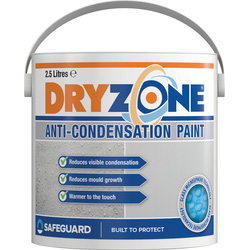Hi, can I paint Dryzone anti-condensation paint (or similar) on a plastic surface, or will it corrode/harm the plastic in some way?
This will be on the underside of plastic roof channel which is prone to condensation, so I can't risk harming the plastic.
I don't have a 'spare' area to test it on, so I would welcome some opinions before I try it. Thanks.

 www.toolstation.com
www.toolstation.com
This will be on the underside of plastic roof channel which is prone to condensation, so I can't risk harming the plastic.
I don't have a 'spare' area to test it on, so I would welcome some opinions before I try it. Thanks.

Dryzone Anti Condensation Paint
• Thermal Effect - microsphere tech • Anti-condensation Paint • Increased time-to-condensation• Interior use onlyDryzone® Anti-Condensation Paint has been specifically designed to reduce condensation from forming on treated surfaces. The glass microspheres in the paint increase the time to...




